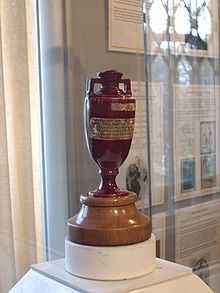Urn


An urn is a vase, ordinarily covered, that usually has a narrowed neck above a footed pedestal.
In Classical terms, an urn is a large decorative covered container of wood, metal, pottery, etc. In furniture, it was a large wooden vase-like container which was usually set on a pedestal on either side of a side table. This was the characteristic of Adam designs and also of Hepplewhite's work. Urns were also used as decorative turnings at the cross points of stretchers in 16th and 17th century furniture designs. The urn and the vase were often set on the central pedestal in a "broken" or "swan's" neck pediment.[1]
Cremation urns
Funerary urns (also called cinerary urns and burial urns) were used by many civilizations. After a person died, survivors cremated the body and collected the ashes in an urn. Pottery urns, dating from about 7000 BC, have been found in an early Jiahu site in China, where a total of 32 burial urns are found,[2] and another early finds are in Laoguantai, Shaanxi.[3] There are about 700 burial urns unearthed over the Yangshao (5000–3000 BC) areas and consisting more than 50 varieties of form and shape. The burial urns were used mainly for children, but also sporadically for adults.[4] In ancient Greece, the lekythos, a type of pottery in ancient Greece, was used for holding oil in funerary rituals. In the Bavarian tradition, a king's heart would be placed in the urn upon his death (as happened with King Otto of Bavaria in 1916). Cremation urns were also commonly used in Anglo Saxon England.[5]
Romans placed the urns in a niche in a collective tomb called a columbarium (literally, dovecote). The interior of a dovecote usually has niches to house doves.
The discovery of a Bronze Age urn burial in Norfolk, England prompted Sir Thomas Browne to carefully describe the antiquities found. He expanded his study to survey burial and funerary customs, ancient and current, and published it as Hydriotaphia or Urn Burial (1658).
In the modern funeral industry, cremation urns of varying quality, elaborateness, and cost are offered, and urns are another source of potential profit for an industry concerned that a trend toward cremation might threaten profits from traditional burial ceremonies.[6][7] Biodegradable urns, made from eco-friendly materials such as coconut shell, compacted peat, cellulose and other natural products that are capable of decomposing back into natural elements, and sometimes including a seed intended to grow into a tree at the site of the burial, were also introduced for both human and animal burial.[8][9][10]
Besides the traditional funeral or cremation ashes urns, it is also possible to keep a part of the ashes of the loved one or beloved pet in keepsake urns or ash jewelry. It is even possible to place the ashes of two people in so-called companion urns. SourceCremation or funeral urns are made from a variety of materials such as wood, nature stone, ceramic, glass, steel, etc.
Other urns


The Ashes, the prize in the biennial Test cricket competition between England and Australia, are contained in a miniature urn.
Urns are a common form of architectural detail and garden ornament. Well-known ornamental urns include the Waterloo Vase.
In mathematics, an urn problem is a thought experiment in probability theory.
A tea urn is a heated metal container traditionally used to brew tea or boil water in large quantities in factories, canteens or churches. They are not usually found in domestic use. Like a samovar it has a small tap near the base for extracting either tea or hot water. Unlike an electric water boiler, tea may be brewed in the vessel itself, although they are equally likely to be used to fill a large teapot.
"Knife urns" placed on pedestals flanking a dining-room sideboard were an English innovation for high-style dining rooms of the late 1760s. They went out of fashion in the following decade, in favour of knife boxes that were placed on the sideboard.
See also
Notes
- ↑ Martin Pegler, The Dictionary of Interior Design.
- ↑ Hu, Yaowu. "Elemental Analysis of Ancient Human Bones from the Jiahu Site," in Acta Anthropologica Sinica, 2005, Vol. 24, No. 2:158–165. ISSN 1000-3193, p. 159.
- ↑ Luan, Fengshi. "On the Origin and Development of Prehistoric Coffin and Funeral Custom," in Cultural Relices, 2006, No. 6:49–55. ISSN 0511-4772, pp. 49–55.
- ↑ Wang, Xiao. "On the Early Funeral Coffin in Central China," in Cultural Relices of Central China, 1997, No. 3:93–100. ISSN 1003-1731. pp. 93-96.
- ↑ See, for example, the Wold Newton urns — www.woldnewton.net.
- ↑ Jessica Mitford, The American Way of Death Revisited (Random House, 2011), ISBN 978-0307809391, pp. 115-116. Excerpts available at Google Books.
- ↑ Stephen R. Prothero, Purified by Fire: A History of Cremation in America (University of California Press, 2002), ISBN 978-0520929746, pp. 196ff. Excerpts available at Google Books.
- ↑ "Biodegradable urns use human remains to grow trees" CBC News, October 21, 2012.
- ↑ [http://news.discovery.com/earth/biodegradable-urn-110517.html#mkcpgn=rssnws1, "RIP: Recycle in Peace"], Discovery News, May 17, 2011.
- ↑ "Biodegradable Urn Lets You Go Green, Even Six Feet Under", Time, May 17, 2011.
External links
| Wikimedia Commons has media related to Urns. |
- Daily Mail article on a Roman cinerary urn
- Getty. Art & Architecture Thesaurus. Urns
- Asian Urn Styles
